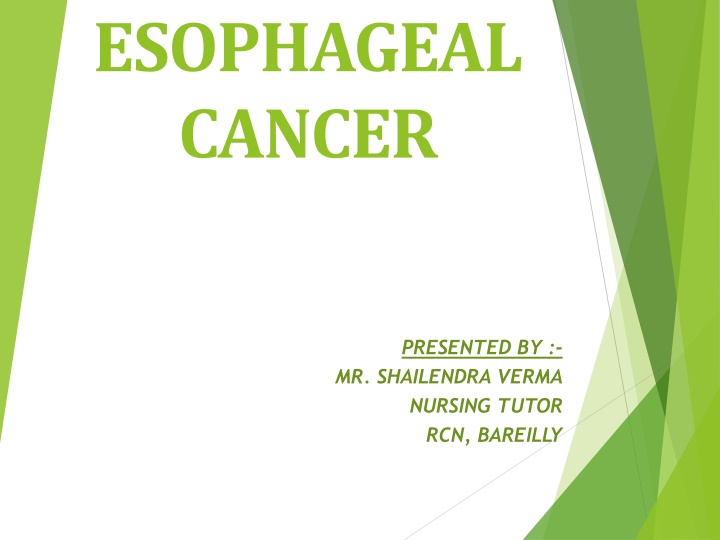
Esophageal Cancer
"Learn about esophageal cancer, its causes, risk factors, symptoms, diagnosis, and management. Explore the incidence rates, anatomy, and physiology of this condition. Discover the role of genetics and lifestyle in developing esophageal cancer."
Download Presentation

Please find below an Image/Link to download the presentation.
The content on the website is provided AS IS for your information and personal use only. It may not be sold, licensed, or shared on other websites without obtaining consent from the author. If you encounter any issues during the download, it is possible that the publisher has removed the file from their server.
You are allowed to download the files provided on this website for personal or commercial use, subject to the condition that they are used lawfully. All files are the property of their respective owners.
The content on the website is provided AS IS for your information and personal use only. It may not be sold, licensed, or shared on other websites without obtaining consent from the author.
E N D
Presentation Transcript
ESOPHAGEAL CANCER PRESENTED BY :- MR. SHAILENDRA VERMA NURSING TUTOR RCN, BAREILLY
SPECIFIC OBJECTIVES On the completion of class teaching the group will be able to:- Introduce the topic Define the Oesophageal cancer & tumor Explain the anatomy and physiology Explain the incidence Enlist the Etiology Describe the pathophysiology Explain the Sign and Symptoms Explain the diagnostic evaluation Describe the Management Enlist Complications
INTRODUCTION Esophageal cancer is the sixth most common cause of cancer deaths worldwide.
DEFINITION Esophageal cancer usually begins in the cells that line the inside of the esophagus. Esophageal cancer can occur anywhere along the esophagus. Esophageal cancer is cancer that occurs in the esophagus a long, hollow tube that runs from your throat to your stomach. Your esophagus helps move the food you swallow from the back of your throat to your stomach to be digested.
INCIDENCE Incidence rates vary within different geographic locations. In some regions, higher rates of esophageal cancer may be attributed to tobacco and alcohol use or particular nutritional habits and obesity. More men than women get esophageal cancer.
ETIOLOGY / RISK FACTORS It's not exactly clear what causes esophageal cancer. Esophageal cancer occurs when cells in the esophagus develop changes (mutations) in their DNA. The changes make cells grow and divide out of control. The accumulating abnormal cells form a tumor in the esophagus that can grow to invade nearby structures and spread to other parts of the body.
SOME RISK FACTORS INCLUDINGS :- Having gastroesophageal reflux disease (GERD) Smoking Having precancerous changes in the cells of the esophagus (Barrett's esophagus) Being obese Drinking alcohol Having bile reflux Having difficulty swallowing because of an esophageal sphincter that won't relax (achalasia) Having a steady habit of drinking very hot liquids Not eating enough fruits and vegetables Undergoing radiation treatment to the chest or upper abdomen
Types of esophageal cancer Esophageal cancer is classified according to the type of cells that are involved. The type of esophageal cancer you have helps determine your treatment options. Types of esophageal cancer include: Adenocarcinoma. Adenocarcinoma begins in the cells of mucus-secreting glands in the esophagus. Adenocarcinoma occurs most often in the lower portion of the esophagus. Adenocarcinoma is the most common form of esophageal cancer in the United States, and it affects primarily white men.
Conti Squamous cell carcinoma. The squamous cells are flat, thin cells that line the surface of the esophagus. Squamous cell carcinoma occurs most often in the upper and middle portions of the esophagus. Squamous cell carcinoma is the most prevalent esophageal cancer worldwide. Other rare types. Some rare forms of esophageal cancer include small cell carcinoma, sarcoma, lymphoma, melanoma and choriocarcinoma.
CLINICAL MANIFESTATION Signs and symptoms of esophageal cancer include: Difficulty swallowing (dysphagia) Weight loss without trying Chest pain, pressure or burning Worsening indigestion or heartburn Coughing or hoarseness
DIAGNOSTIC EVALUATION History collection & physical examination Blood investigation (if needed) Tests and procedures used to diagnose esophageal cancer include: Barium swallow study. During this study, you swallow a liquid that includes barium and then undergo X-rays. The barium coats the inside of your esophagus, which then shows any changes to the tissue on the X-ray. Using a scope to examine your esophagus (endoscopy). During endoscopy, your doctor passes a flexible tube equipped with a video lens (videoendoscope) down your throat and into your esophagus. Using the endoscope, your doctor examines your esophagus, looking for cancer or areas of irritation. Collecting a sample of tissue for testing (biopsy). Your doctor may use a special scope passed down your throat into your esophagus (endoscope) to collect a sample of suspicious tissue (biopsy). The tissue sample is sent to a laboratory to look for cancer cells.
Tests may include: Bronchoscopy Endoscopic ultrasound (EUS) Computerized tomography (CT) Positron emission tomography (PET)
MANAGEMENT What treatments you receive for esophageal cancer are based on the type of cells involved in your cancer, your cancer's stage, your overall health and your preferences for treatment Medical management Cyramza (Ramucirumab) Docetaxel. Enhertu (Fam-Trastuzumab Deruxtecan-nxki) Fam-Trastuzumab Deruxtecan-nxki. Herceptin (Trastuzumab) Keytruda (Pembrolizumab) Lonsurf (Trifluridine and Tipiracil Hydrochloride) Nivolumab.
Conti.. Chemotherapy Chemotherapy is drug treatment that uses chemicals to kill cancer cells. Chemotherapy drugs are typically used before (neoadjuvant) or after (adjuvant) surgery in people with esophageal cancer. Chemotherapy can also be combined with radiation therapy. Radiation therapy Radiation therapy uses high-energy beams, such as X-rays and protons, to kill cancer cells. Radiation typically will come from a machine outside your body that aims the beams at your cancer (external beam radiation). Or, less commonly, radiation can be placed inside your body near the cancer (brachytherapy).
conti.. Combined chemotherapy and radiation Combining chemotherapy and radiation therapy may enhance the effectiveness of each treatment. Combined chemotherapy and radiation may be the only treatment you receive, or combined therapy can be used before surgery. But combining chemotherapy and radiation treatments increases the likelihood and severity of side effects. Targeted drug therapy Targeted drug treatments focus on specific weaknesses present within cancer cells. By blocking these weaknesses, targeted drug treatments can cause cancer cells to die. For esophageal cancer, targeted drugs are usually combined with chemotherapy for advanced cancers or cancers that don't respond to other treatments.
CONTI.. Immunotherapy Immunotherapy is a drug treatment that helps your immune system to fight cancer. Your body's disease- fighting immune system might not attack cancer because the cancer cells produce proteins that make it hard for the immune system cells to recognize the cancer cells as dangerous. Immunotherapy works by interfering with that process. For esophageal cancer, immunotherapy might be used when the cancer is advanced, cancer has come back or the cancer has spread to other parts of the body.
Surgical Management Surgery to remove the cancer can be used alone or in combination with other treatments. Operations used to treat esophageal cancer include: Surgery to remove very small tumors. If your cancer is very small, confined to the superficial layers of your esophagus and hasn't spread, your surgeon may recommend removing the cancer and margin of healthy tissue that surrounds it. Surgery can be done using an endoscope passed down your throat and into your esophagus. Surgery to remove a portion of the esophagus (esophagectomy). During esophagectomy, the surgeon removes the portion of your esophagus that contains the cancer, along with a portion of the upper part of your stomach, and nearby lymph nodes. The remaining esophagus is reconnected to your stomach. Usually this is done by pulling the stomach up to meet the remaining esophagus.
CONTI.. Surgery to remove part of your esophagus and the upper portion of your stomach (esophagogastrectomy). During esophagogastrectomy, the surgeon removes part of your esophagus, nearby lymph nodes and a larger part of your stomach. The remainder of your stomach is then pulled up and reattached to your esophagus. If necessary, part of your colon is used to help join the two. Surgery to remove your esophagus can be performed as an open procedure using large incisions or with special surgical tools inserted through several small incisions in your skin (laparoscopically). How your surgery is performed depends on your individual situation and your surgeon's particular approach to managing it.
ALETERNATIVE THERAPY Acupuncture Guided imagery Massage Relaxation techniques Yoga Ayurveda, etc.
COMPLICATIONS Obstruction of the esophagus. Cancer may make it difficult for food and liquid to pass through your esophagus. Pain. Advanced esophageal cancer can cause pain. Bleeding in the esophagus. Esophageal cancer can cause bleeding. Though bleeding is usually gradual, it can be sudden and severe at times.
SUMMARY After completed my teaching session group improve their knowledge, skills in identifying patient with oesophageal obstruction, and also apply in your future regarding:- Introduce the topic Define the Oesophageal cancer & tumor Explain the anatomy and physiology Explain the incidence Enlist the Etiology Describe the pathophysiology Explain the Sign and Symptoms Explain the diagnostic evaluation Describe the Management Enlist Complications

